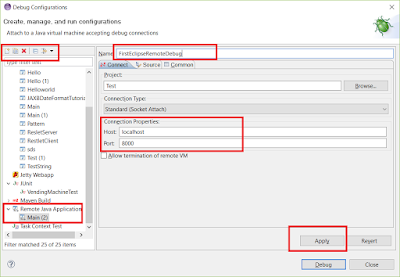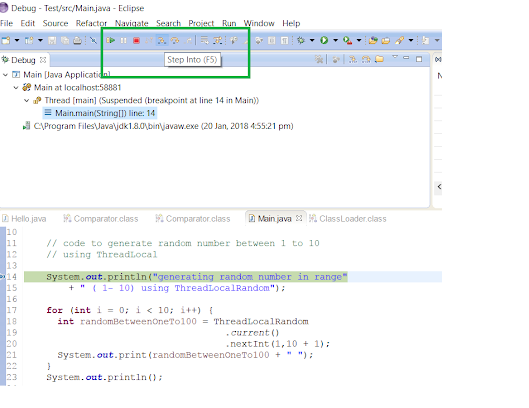How To Use Eclipse Debugger
The remote debugging of the Coffee program is an ultimate tool in the arsenal of a Java developer, which is oftentimes condign the terminal and merely tool to investigate a problems on a Java application running on the remote host similar on a Linux server or Windows server. Nigh all major Coffee IDE provides remote debugging like NetBeans, Eclipse, and IntelliJ IDEA, but I mostly apply Eclipse for Java coding and so information technology's my preferred tool to remote debug a Java program. In order to set upwards remote debugging in Eclipse, you lot demand to do a couple of tasks like you lot need to start your JVM with debugging parameters or arguments and then you need to create a "remote debug configuration" in Eclipse IDE itself.
I have been sharing a lot of Eclipses tips and tricks in this web log like how to escaping JSON strings in Eclipse to hands create JSON for testing and debugging purposes.
In this article, I'll not just teach you how to prepare remote debugging in Eclipse by walking through a stride-past-step guide only also teach you how to actually debug a Java program running on a remote Linux server.
I'll also tell you how to utilise essential debugging commands likeStep Into, Step Over, and how to picket variables while debugging, which will non only helpful during remote debugging simply also during local debugging, correct from Eclipse.
Btw, earlier starting this tutorial, I expect that you are familiar with both Java, JVM, and Eclipse IDE itself because when nosotros talk about Run and Debug configuration, you should sympathize what we are talking about.
I'll prove you every step using the screenshot and explicate to you lot what we are doing and why nosotros are doing merely some basic knowledge of Eclipse is required. If y'all don't know Eclipse or never used Eclipse before, you won't be able to understand whatever I say.
That's why, If you are a complete beginner and so I suggest you first get through a comprehensive Java grade similar The Java MasterClass and Beginners Eclipse Java IDE Preparation Course to learn Coffee and Eclipse a little bit improve before starting with remote debugging. That volition help you to utilize Eclipse IDE effectively for Java development.
3 Steps to Setup Remote debugging of a Java application in Eclipse IDE
1) Start JVM with debug arguments
In lodge to debug a Java awarding running on a remote host(Linus or Windows), you showtime need to start the JVM with debugging arguments, as shown by the following command:
$ /oracle/jre/v1.six.0_18-64scrap/bin/coffee -Xdebug -Xrunjdwp:ship=dt_socket,address=11001,server=y,append=y -jar app.jar Though there are different JVM options to start your JVM in debug mode, depending upon which version of JRE you are using.
If yous're using Java i.4 JRE and so you need to use -Xdebug and -Xrunjdwp arguments. These options will likewise work in afterwards versions, but it will run in interpreted mode instead of JIT, which will be slower.
Btw, I really promise Eclipse should accept something similar to IntelliJ IDEA which makes it easy to remember the JVM debugging options equally shown below:

From Java 5.0, it is better to use the -agentlib:jdwp as a single pick e.g. :
$ java -agentlib:jdwp=transport=dt_socket,server=y,suspend=n,address=11001 Options on -Xrunjdwp or agentlib:jdwp arguments are almost the same:
transport=dt_socket: means the mode used to connect to JVM (the socket is a good choice, it can be used to debug a distant computer)
address=11001: TCP/IP port exposed, to connect from the debugger,
append=y: if 'y', tells the JVM to await until the debugger is attached to brainstorm execution, otherwise (if 'n'), starts execution right away.
If you are debugging for an upshot that happens during startup then you tin can employ the suspend="y" to go through the startup sequence step by step. On the other hand, if the event is happening afterward it receives a message or request and so you can offset with suspend="n" and connect information technology afterwards. Run acrossEclipse Debugging Techniques And Tricksfor more of such tips.

ii. Create a Remote Debug Configuration in Eclipse IDE
You too need to create a remote debug configuration in Eclipse IDE before you commencement debugging. In club to practice and then, merely follow steps:
2.1) Get to debug configuration from Run menu as shown beneath:

2.2) Get to remote Java application
2.3) Configure details eastward.g. name, project, the Eclipse project which contains the lawmaking of the Java application yous are trying to debug. Connection type should exist "socket attach" then specify host and port in Connexion properties every bit shown below. E'er specify a fully qualified domain name for the host
ii.4) Hit use later on making a alter

You are washed with setting up remote debugging in Eclipse. In the next part of this article, I'll show you how to remotely debug a Java application step past pace.
How to Remote debug Coffee Plan in Eclipse
One time you are done with setting up remote debugging in Eclipse IDE, yous can follow these steps to kickoff debugging your remote Coffee plan:
i. Setup a Breakpoint in Your Code
In social club to start debugging, you lot showtime need to set up a breakpoint in your lawmaking. Y'all can fix upward a breakpoint at any line past the just left click of mouse i.east. go to your Java lawmaking and left-click on any line where y'all want to cease the JVM.
This is also known as line breakpoint, btw, don't put line breakpoint on empty lines. Likewise, if you are but starting with debugging, you tin can start past putting a breakpoint in the main() method which is the entry point of the Coffee application.

2. Start JVM with Debug Arguments
Before yous launch your Eclipse remote debugging configuration, you need to start the JVM on the remote host as shown in the following command:
$ /oracle/jre/v1.half dozen.0_18-64scrap/bin/coffee -Xdebug -Xrunjdwp:send=dt_socket,address=11001,server=y,suspend=y -jar app.jar A couple of things to annotation here, nosotros are starting JVM on server mode and request it to append until the debugger connects it, which means information technology will not start execution until y'all offset your Eclipse IDE and launch remote debug.
It is also listening for the debugger on port 11001, which ways your Eclipse remote debugging setting should as well utilise the same port.
Once y'all commencement the JVM, it will print the following line the log file or command line, depending upon where you are redirecting the output stream:
Listening for transport dt_socket at the address: 11001
This means JVM is ready to attach the debugger and now it'southward fourth dimension to get-go remote debugging in Eclipse IDE. Btw, if you are non familiar with Java Virtual machines and then I propose yous go through theUnderstanding the Java Virtual Machine serial on Pluralsight, which explores JVM Memory Direction, Classloading, Security, and other important details.

By the way, yous would need a Pluralsight membership to bring together this course which costs around $29 per month or $299 per twelvemonth (14% discount). I highly recommend this subscription to all programmers as it provides instant access to more than 7000+ online courses to learn any tech skill. Alternatively, you tin as well apply their 10-day-gratis-pass to spotter this course for Costless.
3. Launch your Remote Debug Configuration in Eclipse
Once JVM is started in debug manner and y'all can see the above line in the log file, you can but go and launch the remote debug configuration and double-clicking the configuration you have just created. If JVM is running then it will try to connect information technology using host and port details given in the configuration i.e. 1001 but if JVM is not running then information technology will evidence the following error:

This error means either your JVM is non running just if you are sure that JVM is indeed started and ready to connect and then perchance your host and port configuration is incorrect due east.yard. whatsoever typo on fully qualified domain name or any network issue which preventing your local machine to connect to the remote host.
If your Eclipse IDE is successful to establish a connection to debugger running on remote JVM then Eclipse will open up a debug perspective and you could see where exactly JVM has stopped, a total stack trace starting from loading the classes.
Now, you got control of flying and information technology's up to you how yous motion.
When you offset time debugs a Coffee programme, Eclipse volition ask you to open the Debug Perspective and then next time information technology will automatically do so.
Here is how Eclipse' Debug Perspective look like:

In Debug Perspective, you have a lot of debugging tools like yous can execute code stride by step, can see where you have put breakpoints, can picket values of variables, and tin can come across which thread you are debugging and tin can terminate the debugging session. The debug perspective is the same for both local and remote debugging.
four. Move Step by Step in your Java Code
There are a couple of options to motility in your code you can employ either Step Into for pace by stride executing code, which means if the code contains a method call then your code volition get inside a method so initialize variable and other lawmaking and finally come back to where you were.

Alternatively, you lot can applyStep Over to simply go over the method phone call and motion to the new line. You can employ a combination of these two commands to finer movement effectually an interesting read to observe whatever bug or observer the output in the log file. The push to Footstep Over is only side by side to Step Into every bit seen in the to a higher place screenshot.
5. Sentinel values of Variables
While remote debugging your Coffee application you can also see values of a local variable and member variables into the "Variables" window as shown in the following screenshot:
How To Use Eclipse Debugger,
Source: https://www.java67.com/2018/01/how-to-remote-debug-java-application-in-Eclipse.html
Posted by: allenthwary.blogspot.com


0 Response to "How To Use Eclipse Debugger"
Post a Comment